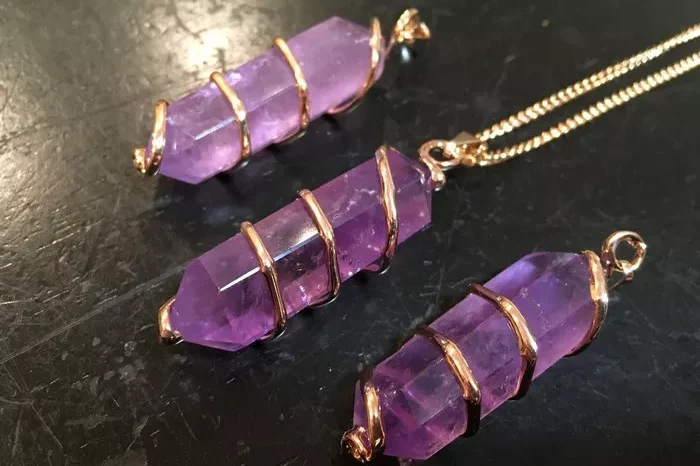Amethyst, a captivating gemstone with its mesmerizing hues of purple, has long held a place of reverence in human history and culture. This violet variety of quartz, known for its stunning color and numerous metaphysical properties, has intrigued and enchanted people for centuries. In this article, we delve into the world of amethyst, examining its origins, characteristics, uses, and significance, shedding light on its unique allure.
The Birth of Amethyst
Amethyst belongs to the illustrious family of quartz, one of the most abundant minerals on Earth’s crust. This violet-hued gemstone derives its captivating color from iron impurities present within the crystal lattice during its formation. The geological conditions that foster amethyst’s growth are closely linked to the presence of silicon dioxide in hydrothermal veins and cavities. As superheated water laden with minerals cools and evaporates, amethyst crystals slowly develop, showcasing their captivating purple tones. The shades can range from pale lavender to deep, rich violet, with certain rare specimens even displaying reddish undertones.
The Allure of Amethyst’s Color
Amethyst’s captivating color has been a major factor contributing to its appeal across various cultures and historical periods. The purple hue, often associated with royalty and nobility, is renowned for its ability to exude an air of luxury and sophistication. This alluring color is often used to craft exquisite jewelry, decorative items, and even religious artifacts, further enhancing its timeless charm.
Is Amethyst Purple Quartz?
Amethyst is indeed a purple variety of quartz. It owes its captivating hue to trace amounts of iron and other minerals present during its formation. Ranging from pale lavender to deep violet, amethyst’s color is a result of the interplay between its crystal lattice and the impurities within. This quartz variant has long held cultural and spiritual significance, symbolizing clarity of thought, spiritual growth, and tranquility. Its exquisite color and inherent metaphysical properties make amethyst a beloved gemstone for jewelry, ornamental pieces, and metaphysical practices, encapsulating the allure of purple within quartz’s crystalline structure.
Cultural Significance and Historical Usage
Amethyst’s significance extends beyond its visual appeal; it has held various symbolic meanings in different cultures throughout history. In ancient Greece, amethyst was believed to ward off the intoxicating effects of alcohol, leading to the creation of amethyst-adorned drinking vessels and jewelry. The word “amethyst” itself is derived from the Greek term “amethystos,” which translates to “not drunk.” This association with sobriety and mental clarity has persisted through the ages.
Furthermore, amethyst has also been revered for its spiritual and healing properties. It is often linked to qualities such as protection, calmness, and spiritual growth. Some cultures believe that wearing amethyst can enhance intuition and promote a deeper connection with the divine. Its regal purple hue is thought to stimulate the third eye and crown chakras, facilitating meditation and inner exploration.
Versatile Applications of Amethyst
Amethyst’s versatility extends beyond its captivating purple hue, making it a sought-after gemstone for various applications:
1. Jewelry:
Amethyst is a popular choice for jewelry, spanning rings, necklaces, earrings, and bracelets. Its elegant color adds a touch of sophistication to both casual and formal attire.
2. Spiritual and Healing Practices:
Amethyst has a long history in spiritual practices. It’s used in meditation to enhance focus, promote spiritual growth, and facilitate connection with higher realms.
3. Home Decor:
Amethyst geodes, clusters, and polished stones are often used as decorative pieces. They add a touch of natural beauty and positive energy to living spaces.
4. Fashion Accessories:
Amethyst can be incorporated into accessories like brooches, hairpins, and cufflinks, offering a touch of elegance and spirituality.
5. Birthstone Jewelry:
Amethyst is the birthstone for February, making it a meaningful choice for individuals born in that month.
Caring for Amethyst
Proper care and maintenance are essential to ensure that amethyst retains its beauty and brilliance over time. Despite its durability, exposure to excessive heat and sunlight should be avoided, as these factors can cause fading of the gemstone’s color. Regular cleaning with mild soapy water and a soft brush will help remove dust and dirt, preserving its natural shine. Additionally, ultrasonic and steam cleaners should be avoided, as they can potentially damage the gemstone.
See Also: Can Chevron Amethyst Go in Water: A Guide to Caring Gemstone
Conclusion
Amethyst, the enchanting purple quartz, continues to captivate hearts and minds with its timeless beauty and multifaceted properties. From its geological origins to its role in cultural symbolism, amethyst’s journey through human history is rich and diverse. Its alluring color, historical significance, versatile applications, and newfound importance in metaphysical practices all contribute to its enduring popularity. As we marvel at the violet depths of this remarkable gemstone, we are reminded of the deep connection between Earth’s treasures and the human spirit.


